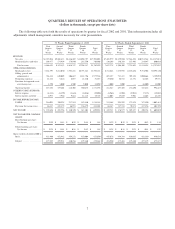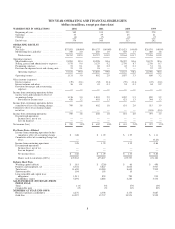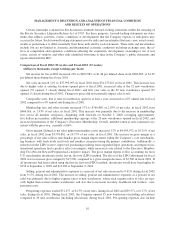Costco 2002 Annual Report Download - page 18
Download and view the complete annual report
Please find page 18 of the 2002 Costco annual report below. You can navigate through the pages in the report by either clicking on the pages listed below, or by using the keyword search tool below to find specific information within the annual report.Stock Options
The Company applies Accounting Principles Board Opinion (APB) No. 25 and related interpretations in
accounting for stock options. The Company grants stock options to employees at exercise prices equal to fair
market value on the date of grant. Accordingly, no compensation cost has been recognized for the plans.
On August 13, 2002 the Company announced that it would adopt the fair value based method of recording
stock options consistent with Statement of Financial Accounting Standards No. 123 (SFAS No. 123) for all em-
ployee stock options granted subsequent to fiscal year end 2002. All future employee stock option grants will be
expensed over the option vesting period based on the estimated fair value at the date the options are granted.
Recent Accounting Pronouncements
In June 2001, the Financial Accounting Standards Board (FASB) issued Statement of Financial Accounting
Standards (SFAS) No. 142, “Accounting for Goodwill and Other Intangibles,” which specifies that goodwill and
some intangible assets will no longer be amortized, but instead will be subject to periodic impairment testing. On
September 3, 2001, the Company adopted SFAS No. 142 and accordingly will continue to test previously re-
ported goodwill for impairment on an annual basis, or more frequently if circumstances dictate. The overall ef-
fect of the adoption of SFAS No. 142 on the Company’s financial statements was not material and the Company
recorded no impairment charge. The reduction in amortization expense going forward, as a result of the adoption,
is not material.
In June 2001, the FASB issued SFAS No. 143, “Accounting for Asset Retirement Obligations,” which pro-
vides the accounting requirements for retirement obligations associated with tangible long-lived assets. SFAS
No. 143 requires entities to record the fair value of a liability for an asset retirement obligation in the period in
which it is incurred. SFAS No. 143 is effective for the Company’s 2003 fiscal year. The adoption of SFAS
No. 143 is not expected to have a material impact on the Company’s consolidated results of operations, financial
position or cash flows.
In August 2001, the FASB issued SFAS No. 144, “Accounting for the Impairment or Disposal of Long-
Lived Assets,” effective for the Company’s 2003 fiscal year. This Statement supersedes FASB Statement
No. 121, “Accounting for the Impairment of Long-Lived Assets and for Long-Lived Assets to Be Disposed Of”
and other related accounting guidance. The adoption of SFAS No. 144 is not expected to have a material impact
on the Company’s consolidated results of operations, financial position, or cash flows.
In April 2002, the FASB issued SFAS No. 145, “Rescission of FASB Statements No. 4, 44 and 64, Amend-
ment of FASB Statement No. 13, and Technical Corrections.” Among other things, this statement rescinds FASB
Statement No. 4, “Reporting Gains and Losses from Extinguishment of Debt,” which required all gains and
losses from the early extinguishment of debt to be aggregated and, if material, classified as an extraordinary item,
net of the related income tax effect. As a result, the criteria in Accounting Principles Board (APB) Opinion
No. 30, “Reporting the Results of Operations – Reporting the Effects of Disposal of a Segment of a Business, and
Extraordinary, Unusual and Infrequently Occurring Events and Transactions,” will now be used to classify those
gains and losses. The statement was effective upon issuance in April 2002 for prospective transactions. The
adoption of this statement had no impact on the Company’s financial position or results of operations in fiscal
2002.
In June 2002, the FASB issued SFAS No. 146, “Accounting for Costs Associated with Exit or Disposal
Activities.” This statement addresses financial accounting and reporting of costs associated with exit or disposal
activities and nullifies Emerging Issues Task Force (EITF) Issue No. 94-3, “Liability Recognition for Certain
Employee Termination Benefits and Other Costs to Exit an Activity (including Certain Costs Incurred in a
Restructuring).” This statement requires that a liability for a cost associated with an exit or disposal activity
should be recognized at fair value when the liability is incurred. SFAS No. 146 is effective for the Company’s
2003 fiscal year. The adoption of SFAS No. 146 is not expected to have a material impact on the Company’s
consolidated results of operations, financial position or cash flows.
17
























